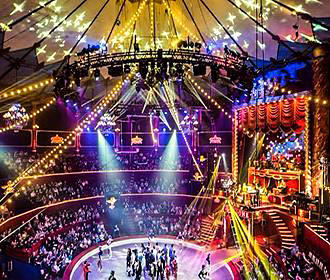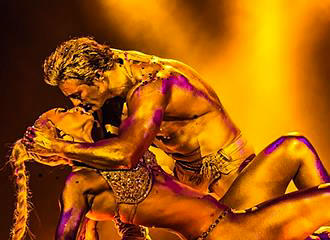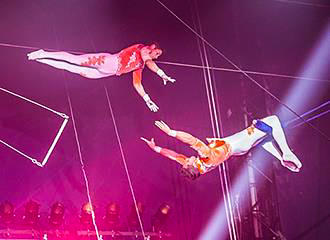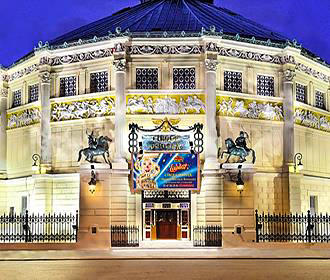Paris Cirque d'Hiver Bouglione History
The flying trapeze, incredible acrobatic acts, animals and clowns, along with fun and laughter for everyone is what we think of when we think of a circus, and the Cirque d'Hiver Bouglione is no exception, plus it is an ideal Paris tourist attraction for a completely different change of scene.
All started with Louis Dejean
The Paris Cirque d'Hiver Bouglione history all started when Louis Dejean wanted to build a place to house a circus in Paris that would be mainly for equestrian shows and a permit for this was granted in the December of 1851.
Louis Dejean admired the work and vision of the architect Jacques Ignance Hittorf who had designed the Gare du Nord train station, so Hittorf was chosen and began on his design in the April of the following year.
The design was an oval with twenty sides and forty windows and a diameter of 42 metres. The facade and the decoration on the outside was entrusted to some incredible sculptors and painters that produced the friezes, statues and high reliefs, which can still be seen today.
On the inside was an oval ring that was surrounded by steeply banked sides for the seating and was similar in style to a coliseum, however, the structure was built in such a way that because it had a low angled roof, it did not need any centre support pole. Therefore, every person in the audience would get an uninterrupted view of the performance and the Paris shows that were to be held here.
Originally when the building was inaugurated in the December of 1852 by Napoleon III, it was named Cirque Napoleon after himself and had been designed to accommodate well over 5000 people and had 21 gas lamps for lighting.
From when this circus in Paris was first opened it started to provide entertainment that was mainly directed towards equestrian shows, however, by 1859 it saw the invention and art of the flying trapeze.
By 1870 the circus acts had not only improved but changed more towards what we think of today and the name of this changed to the Cirque National, yet by 1873 this stopped and became the Paris Cirque d'Hiver Bouglione, which translates to Winter Circus.
Having changed to a theatre at one point, then the improvement from gas lighting to electric lighting in 1907, the building was still being utilised, but not for its true original purpose although it then closed and did not reopen until after World War I.
So, by 1923, the building was taken over by Gaston Desprez and after a complete renovation program including the inside and outside with its paintings, frescos an upgrade to the lighting, it reopened as the Paris Cirque d'Hiver Bouglione in the October of 1923.
In 1933 it changed focus again and became a swimming pool in Paris for a short while, but by the October of 1934 the four Bouglione brothers took over the Paris Cirque d'Hiver Bouglione, winter circus in Paris and made it a mission of their that it would never shut down and continue on the traditions of circus life for years to come.
Professional circus artists came from all over to perform in Paris at the circus, which then took the name of Paris Cirque d'Hiver Bouglione, however, things did not quite go according to plan with the start of World War II and then in December 1940 it was under German occupation.
The Bouglione family did return in 1941 to the Paris Cirque d'Hiver Bouglione and continued with their dreams of the winter circus for many, many years to come, always introducing new members of the family to the arts and always providing audiences with a revised a fresh program in addition to the new international entertainers that were present every year.
The Bouglione family of the Cirque d'Hiver also done promotional stunts such as taking the oldest elephant in the world at the age of 85 up to the first floor of the Eiffel Tower in 1948 to promote the circus tradition in Paris.
Things continued on and in 1999 the new generation of the Bouglione family took over the Cirque d'Hiver Bouglione with the same passion and vision and they embarked on a renovation programme with the help of the Paris government, fans and supporters of the circus.
And as you will no doubt be aware, the history of Paris can be seen wherever, from statues to buildings and bridges to monuments, which are still preserved for all to enjoy when on holiday in Paris and this is exactly what has happened here.
The renovations, both on the inside and on the outside of the building, which has been classified as one of the historical Paris monuments, took over eighteen months of hard work, but the results are impressive and make for an even more enjoyable experience, whether it be visiting the winter circus or going to one of the other shows in Paris that are held here at other times of the year.
But in addition to this, the Bouglione family went one step further to preserve the Paris Cirque d'Hiver Bouglione history by opening up a museum within the very heart of the Cirque d'Hiver called the Musee Bouglione, which is a fascinating place to see what it was like for performers, etc all those years ago.



